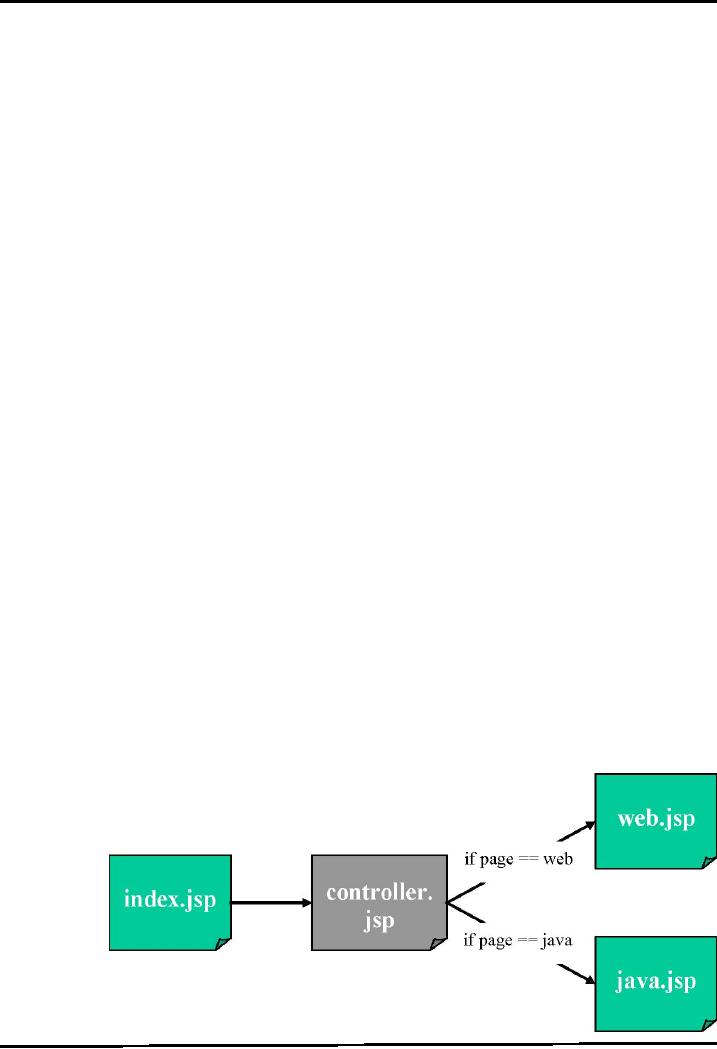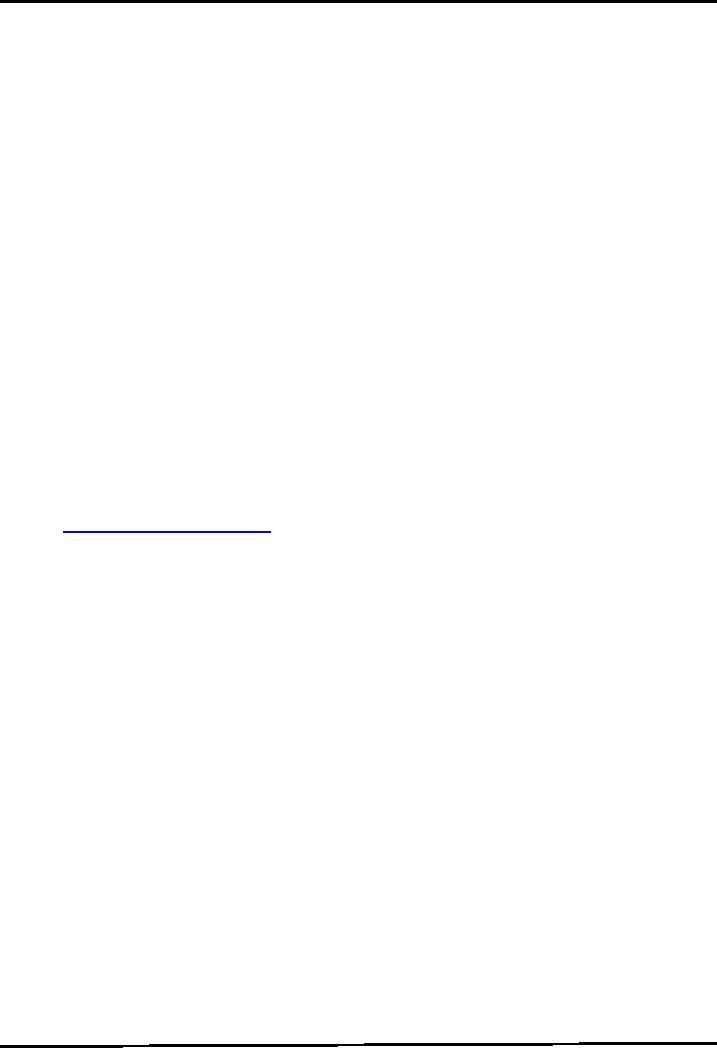 |
JavaServer Pages 2 |
| << Java Server Pages 1 |
| Java Server Pages 3 >> |

Web
Design & Development CS506
VU
Lesson
35
259

Web
Design & Development CS506
VU
Code
Example: Use of Implicit
Objects
The
following example constitutes of 4 JSP
pages. These are index.jsp,
controller.jsp, web.jsp and
java.jsp.
The
user will select either the
option of "java" or "web"
from index.jsp, displayed in the
form of radio
buttons and
submits the request to controller.jsp.
Based on the selection made by the user,
controller.jsp
will
redirect the user to respective
pages (web.jsp or
java.jsp).
The
flow of the example is shown below in the
pictorial form.
The
code of these entire pages
is given below.
index.jsp
<html>
<body>
<h2>
Select
the page you want to
visit</h2>
<form
name="myForm" action="controller.jsp"
>
<h3>
<input
type="radio" name = "page"
value="web"/>
Web
Design & Develoment
</h3>
<br>
<h3>
<input
type="radio" name = "page"
value="java"/>
Java
</h3>
<br>
<input
type="submit" value="Submit" />
</form>
</body>
</html>
controller.jsp
<html>
<body>
<!--
scriptlet -->
<%
//
reading parameter "page",
name of radio button
using
//
implicit object
request
String
pageName = request.getParameter("page");
//
deciding which page to move
on based on "page"
value
//
redirecting user by using
response implicit
object
if
(pageName.equals("web")) {
response.sendRedirect("web.jsp");
}
else if (pageName.equals("java") )
{
response.sendRedirect("java.jsp");
}
%>
</body>
</html>
web.jsp
<html>
<body>
//
use of out implicit object,
to generate HTML
<%
out.println(
"<h2>" +
"Welcome
to Web Design & Development Page"
+
"</h2>"
260

Web
Design & Development CS506
VU
);
%>
</body>
</html>
java.jsp
<html>
<body>
//
use of out implicit object,
to generate HTML
<%
out.println(
"<h2>" +
"Welcome
to Java Page" +
"</h2>"
);
%>
</body>
</html>
The
details of remaining 5 implicit
objects are given
below:
session
This
variable is of type HttpSession, used to
work with session
object.
application
This
variable is of type ServletContext.
Allows to store values in key-value
pair form that
are
shared
by all servlets in same web
application
config
This
variable is of type ServletConfig.
Represents the JSP
configuration options e.g.
init-
parameters
etc.
Page
Context
This
variable is of type
javax.servlet.jsp.PageContext, to give a
single point of access
to
many
of the page attributes. This
object is used to stores the
object values associated
with
this
object.
exception
This
variable is of type java.lang.Throwable.
Represents the exception
that is passed to JSP
error
page.
page
This
variable is of type java.lang.Object. It
is synonym for this.
JSP
Directives
JSP
directives are used to
convey special processing information
about the page to JSP
container. It affects
the
overall structure of the servlet that
results from the JSP page.
It enables programmer to:
Specify page settings
To
Include content from other
resources
To
specify custom-tag libraries
Format
<%@
directive {attribute="val"}* %>
In
JSP, there are three types of directives:
page, include & taglib.
The formats of using these
are:
page:
<%@
page
{attribute="val"}*
%>
include:
<%@
include
{attribute="val"}*
%>
taglib:
<%@
taglib
{attribute="val"}*
%>
JSP
page Directive
Give
high level information about
servlet that will result
from JSP page. It can be
used anywhere in the
document. It
can control
261

Web
Design & Development CS506
VU
Which classes are
imported
What class the servlet
extends
What MIME type is
generated
How multithreading is
handled
If the
participates in session
Which page handles unexpected errors
etc.
The
lists of attributes that can
be used with page directive
are:
language
=
"java"
extends
=
"package.class"
import
=
"package.*,package.class,..."
session
=
"true
|
false"
Info
=
"text"
contentType
=
"mimeType"
isThreadSafe
=
"true
|
false"
errorPage
=
"relativeURL"
isErrorPage
=
"true | false"
Some
example uses are:
To
import package like
java.util
<%@page
import="java.util.*" info="using util
package" %>
To declare
this page as an error
page
<%@
page isErrorPage = "true" %>
To
generate the excel spread
sheet
<%@
page contentType =
"application/vnd.ms-excel" %>
JSP
include Directive
Lets
you include (reuse)
navigation bars, tables and
other elements in JSP page.
You can include files
at
Translation Time (by using
include directive)
Request Time (by using
Action elements, discussed in
next handouts)
Format
<%@include
file="relativeURL"%>
Purpose
To
include a file in a JSP document at the
time document is translated into a
servlet. It may contain
JSP
code
that affects the main page
such as response page header
settings etc.
Example
Code: using include
directive
This
example contains three JSP pages.
These are index.jsp, header.jsp &
footer.jsp. The header.jsp
will
display
the text of "web design and development"
along with current date. The
footer.jsp will display
only
"virtual
university". The outputs of both
these pages will be included
in index.jsp by using JSP
include
directive.
header.jsp
<%@page
import="java.util.*"%>
<html>
<body>
<marquee>
<h3>
Web Desing & Development
</h3>
<h3><%=new
Date()%></h3>
262

Web
Design & Development CS506
VU
</marquee>
</body>
</html>
footer.jsp
<html>
<body>
<marquee>
<h3>
</h3>
</marquee>
</body>
</html>
index.jsp
<html>
<body>
//
includes the output of header.jsp
<%@include
file="header.jsp" %>
<TABLE
BORDER=1>
<TR><TH></TH><TH>Apples<TH>Oranges
<TR><TH>First
Quarter<TD>2307<TD>4706
<TR><TH>Second
Quarter<TD>2982<TD>5104
<TR><TH>Third
Quarter<TD>3011<TD>5220
<TR><TH>Fourth
Quarter<TD>3055<TD>5287
</TABLE>
//
includes the output of
footer.jsp
<%@include
file="footer.jsp" %>
</body>
</html>Example
Code: setting content type to generate
excel spread
sheet
In
this example, index.jsp is
modified to generate excel
spread sheet of the last example.
The change is
shown in
bold face.
index.jsp
//
setting content type to generate
excel sheet using page
directive
<%@page
contentType="application/vnd.ms-excel" %>
<html>
<body>
//
includes the output of header.jsp
<%@include
file="header.jsp" %>
<TABLE
BORDER=1>
<TR><TH></TH><TH>Apples<TH>Oranges
<TR><TH>First
Quarter<TD>2307<TD>4706
<TR><TH>Second
Quarter<TD>2982<TD>5104
<TR><TH>Third
Quarter<TD>3011<TD>5220
<TR><TH>Fourth
Quarter<TD>3055<TD>5287
</TABLE>
//
includes the output of
footer.jsp
<%@include
file="footer.jsp" %>
</body>
</html>
JSP
Life Cycle Methods
The
life cycle methods of JSP
are jspInit(), _jspService() and
jspDesroy(). On receiving
each
263
Table of Contents:
- JAVA FEATURES
- Java Virtual Machine & Runtime Environment
- Learning Basics of JAVA
- JAVA: Object Oriented Programming
- JAVA: Inheritance
- JAVA: Collections
- JAVA: Intro to Exceptions
- JAVA: Streams
- JAVA: Modification of Address Book Code
- JAVA: Graphical User Interfaces
- JAVA: Event Handling
- JAVA: More Examples of Handling Events
- JAVA: Problem in Last Code Example
- Java Database Connectivity
- JAVA: More on JDBC
- JAVA: Result Set
- JAVA: Meta Data
- Java Graphics
- JAVA: How to Animate
- JAVA Applets
- JAVA: Socket Programming
- JAVA: Serialization
- JAVA: Multithreading 1
- JAVA: Multithreading 2
- JAVA Web Application Development
- Java Servlets
- JAVA: Creating a Simple Web Application in Tomcat
- JAVA: Servlets Lifecycle
- JAVA: More on Servlets
- JAVA: Dispatching Requests
- JAVA: Session Tracking 1
- JAVA: Session Tracking 2
- JAVA: AddressBook Case Study Using Sevlets
- Java Server Pages 1
- JavaServer Pages 2
- Java Server Pages 3
- JAVA: JSP Action Elements and Scope
- JAVA: JSP Custom Tags
- JAVA: MVC + Case Study
- JAVA: MVC Model 2 Architecture
- JAVA: Layers and Tiers
- JAVA: Expression Language
- JAVA: JavaServer Pages Standard Tag Library (JSTL)
- JAVA: Client Side Validation & JavaServer Faces (JSF)
- JAVA: JavaServer Faces